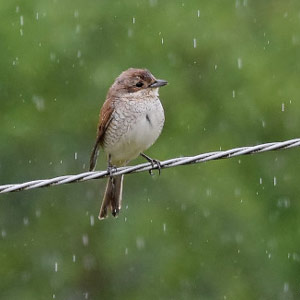Pratique | Débuter
Les effets possibles d’un printemps pluvieux sur la reproduction des oiseaux

Pie-grièche écorcheur (Lanius collurio) sous la pluie : la nidification des oiseaux peut être perturbée par des précipitations printanières prolongées.Photographie : Christine Bonici
Introduction
La reproduction des oiseaux est influencée par de nombreux facteurs, notamment les conditions climatiques : elles peuvent par exemple avancer ou retarder le début de la période de la nidification, modifier les habitats, réduire ou augmenter la quantité de nourriture disponible ou provoquer une baisse ou une hausse de la température corporelle des oisillons. En Europe de l’Ouest, le printemps 2016 est particulièrement pluvieux, provoquant des crues importantes. En France, la pluviométrie a par exemple été excédentaire de plus de 25 %. Les précipitations printanières importantes peuvent avoir différentes conséquences négatives sur les oiseaux, en particulier insectivores, comme la diminution du nombre de jeunes élevés avec succès ou un affaiblissement des adultes.
Dans cet article, nous recensons les impacts possibles des fortes précipitations sur la nidification des oiseaux, nous abordons le cas particulier des espèces désertiques et tropicales et nous évoquons le rôle futur possible du réchauffement climatique qui devrait s’accompagner d’une augmentation de la quantité de précipitations dans le nord et le centre de l’Europe.
Abstract
Bird breeding is influenced by many factors, including climatic conditions: they may accelerate or delay the beginning of the breeding period, modify habitats, reduce or increase the amount of available food or decrease or increase the body temperature of chicks. In Western Europe, spring 2016 is particularly rainy, causing major floodings. In France for example, rainfall has been 25% higher than during a normal spring. Major spring precipitations can have various negative effects on bird reproduction, especially insectivores, including a diminution of the fledging success and the juvenile and parental survivals. In this article, we identify the potential impacts of heavy rainfalls on breeding birds, we speak about the case of desert and tropical birds species and we discuss about the possible future role of global warming that is expected to increase rainfalls in northern and central Europe.
Poursuivez la lecture de cet article, en vous abonnant dès maintenant !
Découvrez les Archives d’Ornithomedia.com
Pour seulement 10,00 €TTC/an (ou 6,00 € les 6 mois)
Profitez de plusieurs centaines d’articles en accès illimité et sans aucun engagement.
Compléments
À lire aussi sur Ornithomedia.com
- Inondations et nidification des oiseaux : quelques exemples d’adaptations
- Les Buses rouilleuses nicheuses se prépareraient à l’approche d’un ouragan
- L’organe paratympanique, le baromètre interne des oiseaux
- Parade des Grèbes huppés : postures, danses et cérémonies
- Les différents types de nichoirs
- Le lac de Maine, un fragile équilibre entre oiseaux et loisirs
- Le nomadisme des alouettes désertiques : un exemple en Tunisie
- Oiseau blessé ou oisillon tombé du nid : que faire ?
Sources
- Meit Öberg et al (2015). Rainfall during parental care reduces reproductive and survival components of fitness in a passerine bird. Ecology and Evolution. Volume : 5. Numéro : 2. Pages : 345–356. http://onlinelibrary.wiley.com/doi/10.1002/ece3.1345/full
- Thomas Oliver Mero et al (2014). Effect of reed burning and precipitation on the breeding success of Great Reed Warbler, Acrocephalus arundinaceus, on a mining pond. Turkish Journal of Ornithology. Numéro 38. Pages : 622-630. http://journals.tubitak.gov.tr/zoology/abstract.htm?id=15243
- G. A. Tyler et R. E. Green (2004). Effects of weather on the survival and growth of Corncrake Crex crex chicks. Volume 146. Numéro : 1. Pages : 69–76. Janvier. http://onlinelibrary.wiley.com
- R. W. Summers et al (2004). An experimental study of the effects of predation on the breeding productivity of capercaillie and black grouse. Journal of Applied Ecology. Volume 41. Numéro 3. Pages : 513–525. http://onlinelibrary.wiley.com/doi/10.1111/j.0021-8901.2004.00891.x/full
- A. et R. Kostrzewa (2008). The relationship of spring and summer weather with density and breeding performance of the Buzzard Buteo buteo, Goshawk Accipiter gentilis and Kestrel Falco tinnunculus. Ibis.
Volume : 132. Numéro : 4,. Pages : 550–559. Octobre. http://onlinelibrary.wiley.com/doi/10.1111/j.1474-919X.1990.tb00278.x/abstract - Penn Lloyd (1999). Rainfall as a breeding stimulus and clutch size determinant in South African arid-zone birds. Volume : 141. Numéro : 4. Pages : 637–643. Octobre. http://onlinelibrary.wiley.com/doi/10.1111/j.1474-919X.1999.tb07371.x/abstract
- Michael A. Patten et John T. Rotenberry (1999). The Proximate Effects of Rainfall on Clutch Size of the California Gnatcatcher. The Condor. Volume : 101. Numéro : 4. Pages : 876-880. www.jstor.org/stable/1370080?seq=1#page_scan_tab_contents
- J. T. García et B. E. Arroyo (2001). Effect of abiotic factors on reproduction in the centre and periphery of breeding ranges: a comparative analysis in sympatric harriers. Ecography. Volume : 24,. Numéro : 4. Pages : 393–402. Août. http://onlinelibrary.wiley.com/doi/10.1111/j.1600-0587.2001.tb00474.x/abstract
- Janos Torok et Laszlo Toth (1988). Density Dependence in Reproduction of the Collared Flycatcher (Ficedula albicollis) at High Population Levels. Volume : 57. Numéro : 1. Pages : 251-258. Février. www.jstor.org/stable/4776?seq=1#page_scan_tab_contents
- Ziemowit Kosinski et Pawel Ksit (2006). Comparative reproductive biology of Middle Spotted Woodpeckers Dendrocopos medius and Great Spotted Woodpeckers D. major in a riverine forest. Bird Study. Volume : 53. Numéro : 3. Pages : 237-246. www.tandfonline.com/doi/abs/10.1080/00063650609461438
- W. Dean. The distribution and biology of nomadic birds in the Karoo, South Africa. Journal of Biogeography. Volume : 24. Numéro : 6. Pages : 769–779. http://onlinelibrary.wiley.com/doi/10.1046/j.1365-2699.1997.00163.x/full
- Marie-Hélène Dickey et al (2008). Climatic effects on the breeding phenology and reproductive success of an arctic-nesting goose species. Global Change Biology. Volume : 14. Numéro : 9. Pages: 1973–1985. Septembre.http://onlinelibrary.wiley.com/doi/10.1111/j.1365-2486.2008.01622.x/full
- Andrew N Radford (2003). The importance of rainfall to a cavity-nesting. Ibis. Octobre. www.researchgate.net
- Par Anders Pape Møller,Wolfgang Fiedler et Peter Berthold (2010). Effects of Climate Change on Birds. OUP Oxford.
- Scott A. Morrison et Douglas T. Bolger (2002). Variation in a sparrow’s reproductive success with rainfall: food and predator-mediated processes. Oecologia. Volume 133. Numéro : 3. Pages: 315-324. http://rd.springer.com/article/10.1007/s00442-002-1040-3#page-1
- Jesús M. Avilés , Bård G. Stokke, Arne Moksnes, Eivin Røskaft et Anders P. Møller (2007). Behavioral Ecology and Sociobiology. Volume : 61. Numéro : 3,. Pages : 475-485. http://link.springer.com/article/10.1007/s00265-006-0275-0





Aucun commentaire sur ce sujet
Participer à la discussion !